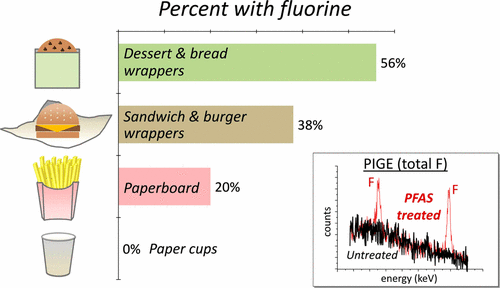
A new study shows how levels of fluorine in fast food wrappers and other packaging. Credit: American Chemical Society
There may be a hidden danger the next time you decide to splurge on fast food.
According to a new study, several popular fast food containers, including hamburger and sandwich wrappers, pastry bags, beverage cups and French fry containers, may contain fluorinated compounds called perfluoroalkyl and polyfluoroalkyl substances (PFASs), which are linked to kidney and testicular cancers, thyroid disease, low birth weight and immunotoxicity in children.
A research team tested more than 400 samples of packaging materials and found PFASs in 56 percent of the dessert and bread wrappers, 38 percent of sandwich and burger wrappers and 20 percent of paperboard. The study did not include takeout containers like Chinese food boxes or pizza boxes.
Researchers used an efficient and cost-effective method called particle-induced gamma-ray emission (PIGE) spectroscopy to analyze the total fluorine content of each piece of packaging.
A liquid chromatography/high-resolution mass spectrometry analysis of a subset of 20 samples found perfluorocraboxylates, perfluorosulfonates and other known PFASs and/or unidentified polyfluorinated compounds.
The total peak area for PFASs was higher in 10 of 14 samples with a total fluorine level of greater than 200 nmol/cm² compared to six samples with a total fluorine level less than 16 nmol/cm².
The study also found that samples with a high total fluorine level, but low level of measured PFASs may have contained volatile PFAS, PFAS polymers, newer replacement PFASs or other fluorinated compounds.
According to the study’s abstract, PFASs in grease-resistant food packaging can leach into food and increase dietary exposure.
Graham Peaslee, a professor of experimental nuclear physics in the College of Science at the University of Notre Dame, said the chemicals have a long half-life and take several years before just 50 percent of the intake leaves the human body.
“These chemicals don’t biodegrade,” Peaslee, who tested the samples, said in a statement. “They don’t naturally degrade. They persist in the environment for a very long time.”
According to Peaslee, PFASs can migrate throughout the body when consumed.
“This is a really persistent chemical,” Peaslee said. “It gets in the bloodstream, it stays there and accumulates. There are diseases that correlate to it, so we really don’t want this class of chemicals out there.”
The results come at a time when about one-third of U.S. children consume fast food daily, according to the National Center for Health Statistics.
Samples were collected from 27 fast food restaurant chains, including some of the country’s most recognizable brands in and around Boston, San Francisco, Seattle, Washington D.C., and Grand Rapids, Mich.
Co-authors include researchers and scientists from the Silent Spring Institute, the California Department of Toxic Substances Control, the Green Science Policy Institute, the Environmental Working Group, the U.S. Environmental Protection Agency and the Oak Ridge Institute for Science and Education, as well as the University of California at Berkeley and Hope College.
The study was published in Environmental Letters & Technology Letters




